Day Tripping to Head-Smashed-In Buffalo Jump, Alberta, Canada – Join us on a mini-adventure to visit one of Alberta’s six UNESCO World Heritage Sites. It’s a story that spans over 5,000 years. Somewhere in the neighbourhood of 100,000 bison went over the cliff, sustaining generation after generation of Plains people. It boggles the mind when you start to learn about the prehistory and history of the Plains Buffalo Culture at Head-Smashed-In Buffalo Jump.
Disclosure: This post contains affiliate links. If you buy something from one of our affiliates, we receive a small commission at no extra charge to you. Thanks for helping to keep our blog up and running!
Table of Contents
Walking into the Past
It was like taking a step back in time – way back in time – onto the prairies in Southern Alberta 500 years before the first Egyptian pyramid was built. The air was acrid with smoke from summer forest fires as we stepped out onto the cliff. Wind tossed hair around our faces. We walked forward with purpose. In the distance, we could hear the sound of hoofbeats. They were slow at first and then pounding faster and faster…
Okay, maybe it was just me! Truth be told, I have a pretty good imagination. Today’s path is made of concrete and fenced with metal posts and rail. Still, there is something about standing on top of the jump that creates a sense of wonder. The first bison were driven over the cliff over 5,500 years ago.
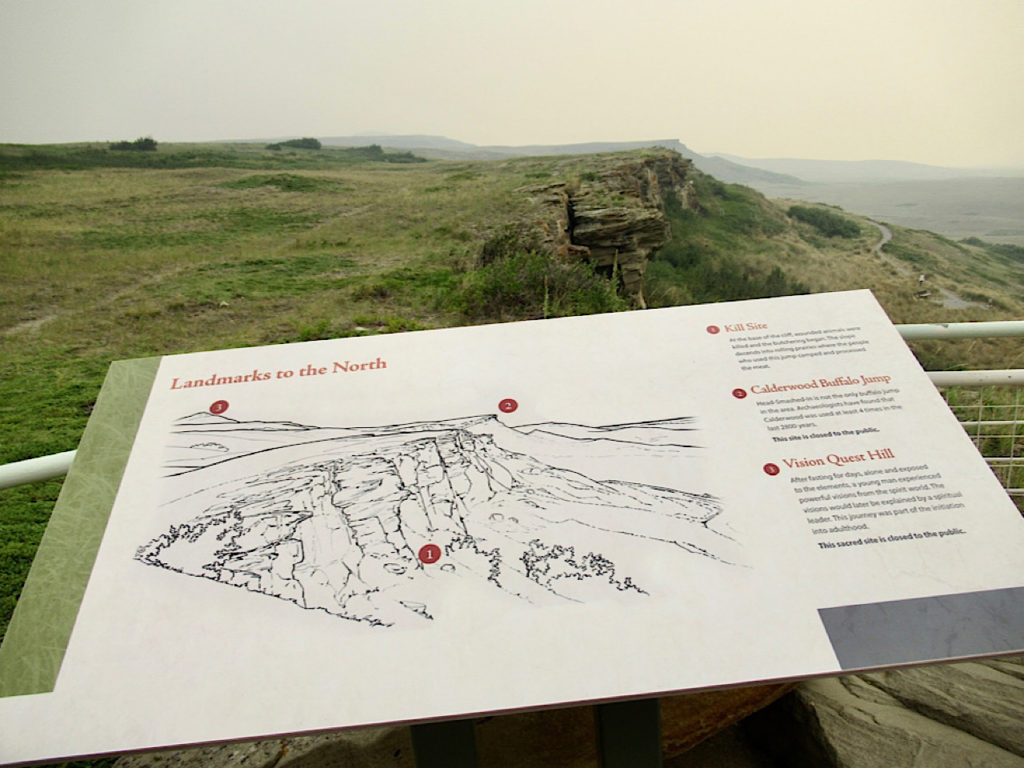
Let me take a step back for a minute.
First of all, what is Head-Smashed-In Buffalo Jump?
Secondly, where is it located?
And finally, why should you add this Alberta adventure to your must-do list?
All About Head-Smashed-In Buffalo Jump
This buffalo jump is one of the deepest, oldest and best-preserved bison kill sites in North America. It is located on a cliffside at the southeastern edge of the Porcupine Hills, near Fort Macleod, Alberta. Head-Smashed-In Buffalo Jump is a world-class cultural site with an impressive, multi-story Interpretive Centre that leads visitors from the past to the present.
As a result of its significance, the area became a National Historic Site in 1968. Thirteen years later – in 1981 – it became a UNESCO World Heritage Site. Yes, this relatively small site in Southern Alberta is in the same league as Peru’s Machu Piccu, France’s Palace of Versailles and England’s Stonehenge! The Interpretive Centre officially opened in July of 1987.
Interested in discovering other Alberta-based, UNESCO World Heritage Sites?
Check out our post on the Milk River for a paddle down to Writing-on-Stone!
Did You Know?
Buffalo are huge part of the folklore of the North American Plains, but there is no such thing as a North American buffalo! The name “buffalo” only applies to animals found in Africa and Asia. Our “buffalo” is actually a bison. But the popular name of buffalo has stuck and both terms are used regularly. Thus, Head-Smashed-In Buffalo – not bison – Jump.
At Head-Smashed-In, member of the Blackfoot tribes hunted the Plains bison. This species of bison occupied much of the central region of North America for thousands of years. No one knows exactly how many bison existed at their highest numbers, but it was in the tens of millions of animals.
And the site has another unique naming feature! It’s easy to assume that “Head-Smashed-In” refers to the bison killed at the site. Nope. According to legend, a young man was found near the cliff, his skull crushed by the weight of the bison carcasses.
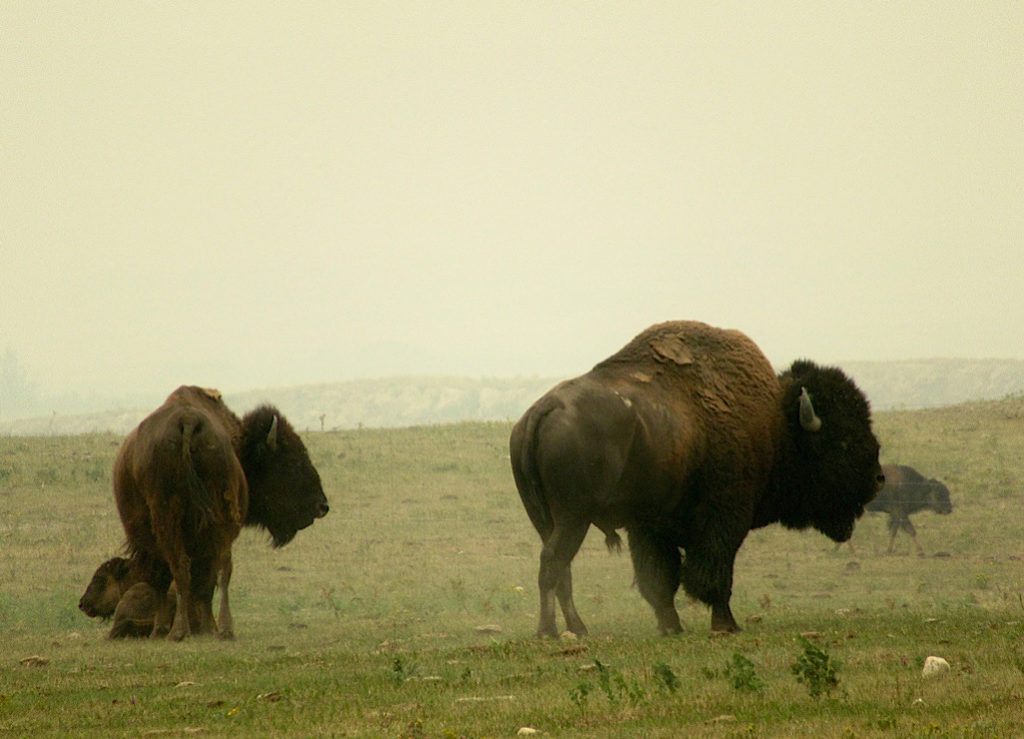
How Does a Buffalo Jump Work?
Plains people relied on their collective wisdom and knowledge of topography and bison behaviour to hunt these massive animals. They mastered buffalo jumps long before they ever saw a horse or bow or gun.
Spiritual ceremonies were held to ensure a safe and successful hunt. Runners were sent to locate and start slowly herding the animals closer to the jump site. This area is called the gathering basin. V-shaped drive lanes lined with stone cairns helped funnel the herds of bison in the right direction. Remnants of these cairns are still found today.
As the herd drew closer, people hiding behind the cairns and brush would stand up and start shouting and waving their arms. The herd would panic and thunder over the cliff to their death. The animals were processed in the butchering camp set up below the precipice.
Bison was essential for Plains tribes. Almost every part of the animal is used. Meat, fat and bone marrow is eaten. Hides were used for clothing and shelter. Bones are shaped into tools. Horns are made into spoons. Bison tongues were often given to medicine men or women, who were responsible for ceremonies ensuring the success of a hunt.
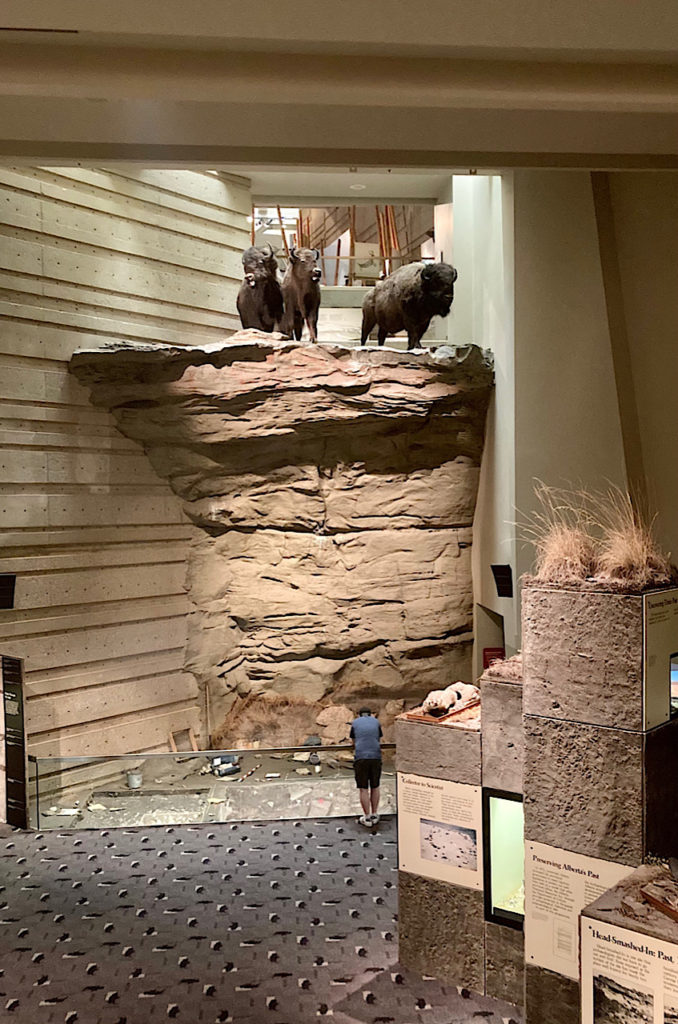
Stepping Inside This Cultural Adventure
After viewing the jump site, my niece and I went back into the interpretive centre and started working our way down the levels – starting with a captivating video and explanation of Napi’s World. Another level introduced Napi’s people and life on the plains. The museum’s open design allows glimpses of the herd at the cliff edge before we walked down to the Buffalo Hunt and into the theatre for a flashback to all of the action.
Cultures in Contact took our breath away. The piles of skulls in historic photos were mind-numbing. Bison hunting had become a sport by non-native people. By the end of the 19th century, the mighty herds of bison were decimated. Less than 1,000 plains bison are left. European contact brought in human diseases as well. Before long, more than just the bison population was in peril.
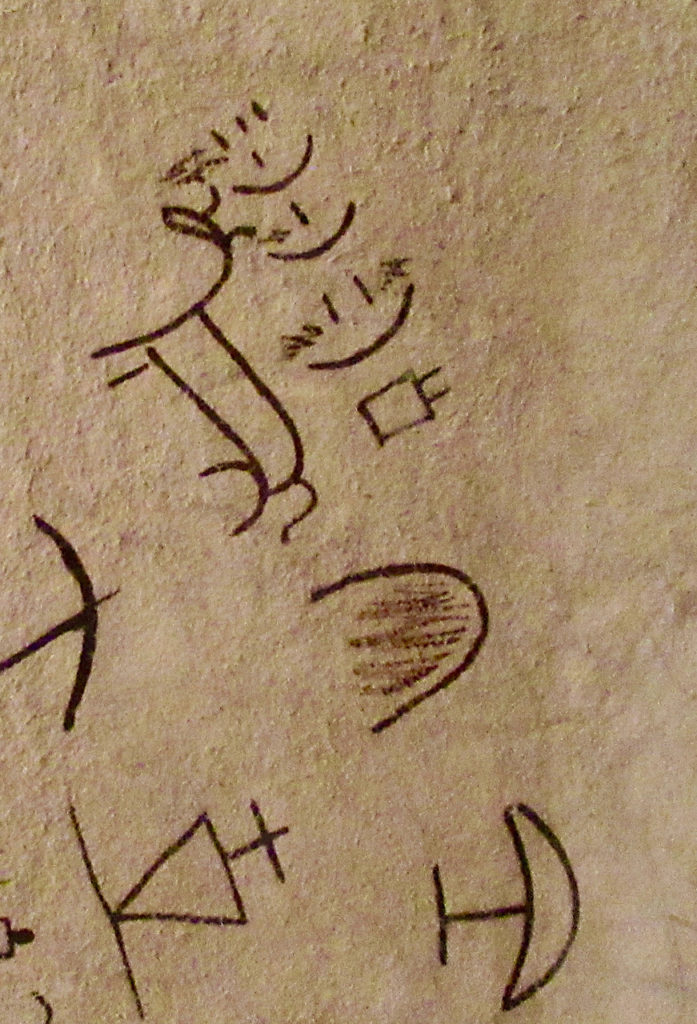
Archaeology at Head-Smashed-In
We wandered through the final level, Uncovering the Past, appreciating the film with archaeologists talking about their interpretation of the finds and their meanings. Head-Smashed-In Buffalo Jump was the first site in Alberta to be excavated by a professional archaeologist.
In 1938, Junius Bird from the American Museum of Natural History spent a few days at the site and did some cursory testing. Eleven years later, archeology student Boyd Wettlaufer from the University of New Mexico spent a summer working at Head-Smashed-In. His work that summer was the first archaeological excavation in Alberta.
Subsequent archaeological digs have increased understanding of this unique and complex archaeological site. The Head-Smashed-In site includes three different components spread out over 1,470 acres. There is the gathering basin, the kill site, and the campsite and processing area. Each area has different kinds of archaeological remains.
Together, these remains help tell the story of Head-Smashed-In. The oldest evidence of humans in the area are two spear points – believed to be 9,000 years old! Radiocarbon dating of the bones show the site was an active buffalo jump 5,700 years ago.
The layers show changes in technology. The uppermost layers at Head-Smashed-In Buffalo Jump have metal arrowheads. These show that the jump was used in historic times – after European contact. With the signing of Treaty No. 7 in 1877 at Blackfoot Crossing, the Plains people settled on reserves in Southern Alberta. The great herds are gone. The buffalo jump is no longer needed.
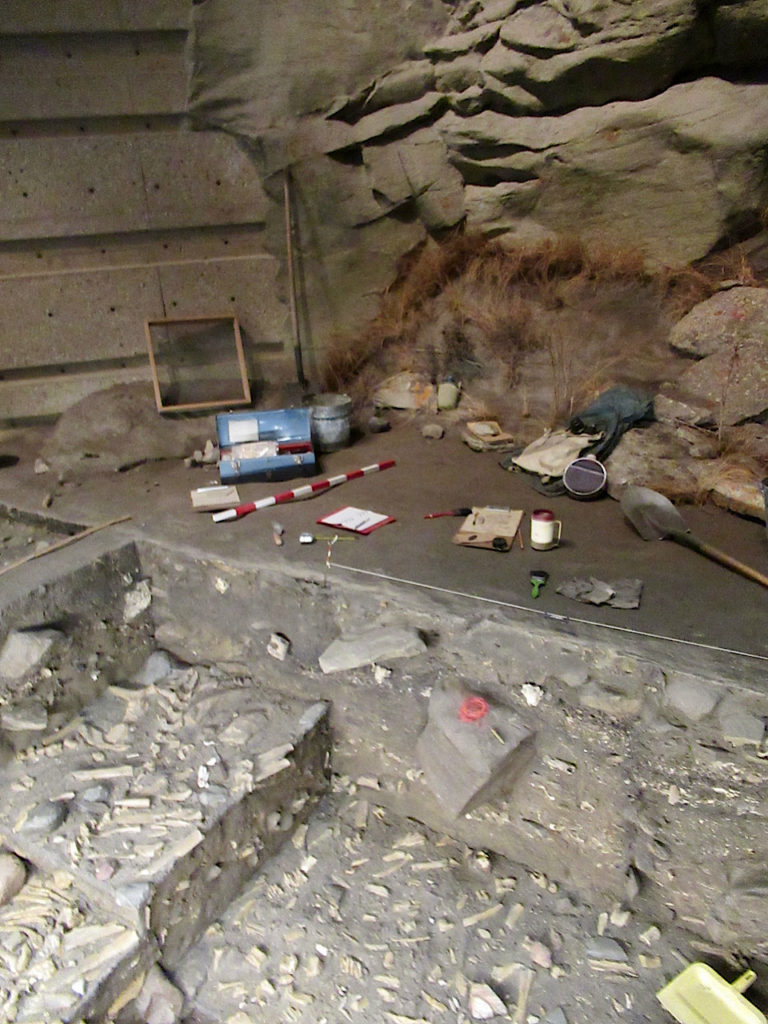
Bringing the Past to Life
The interpretive centre is full of great information, captivating films and thought-provoking photos, but it was a chance encounter with an interpreter who brought it all to life. We were standing at a wall of black-and-white photos for an exhibit called: Rediscovering the Voices.
“Photographs can speak. They can whisper or shout. They can lie. Many photographs though, are silent. Every time the people, event or places shown in a picture are not know, the photograph has lost a voice. When a drawing on a tipi or robe aren’t explained, another voice is silenced…”
We were talking about the photos and how the exhibit brought such an important topic to light when a man came out of a nearby office.
“How are you enjoying your visit?” he asked.
“It’s been very good,” I replied. “However, we’re especially appreciating this exhibit.”
“You’ve both had your shots?” he queried.
“Yes,” we answered in unison.
“I guess I can talk with you then.”
And with that, he launched into a discussion about the photos, the faces, the photographers. He questioned our impressions and told us what he knew. He brought everything to life with a few simple guided words.
It made our day.
I cannot wait to revisit the museum when all of the interpreters are back, sharing their voices and their knowledge and illuminating the amazing prehistory and history of Head-Smashed-In Buffalo Jump. The displays and films are good, but it is truly the people who make it real, who bring the past to life.
PIN THIS POST FOR FUTURE REFERENCE!
When You Go
Hours of Operation: Due to the pandemic, the Interpretive Centre is self-guiding for Summer 2021, but visitors can still enjoy the Viewpoint, exhibits and theatre presentations. It is open 10-5 daily until September 7, 2021. The site will be fully open again in 2022.
Location: Head-Smashed-In Buffalo Jump is located 18 kilometres northwest of Fort Macleod on the paved secondary Highway #785 (west off Highway #2).
Nearby RV Camping Option: River’s Edge RV Park offers 15 and 30 Amp Service with River Front and Pull Thru sites available.
Looking for additional Southern Alberta adventures? Check out our posts about Cycling the Crowsnest Community Trail and Exploring the Crowsnest Pass: Hillcrest Mine Disaster – both just an hour away!
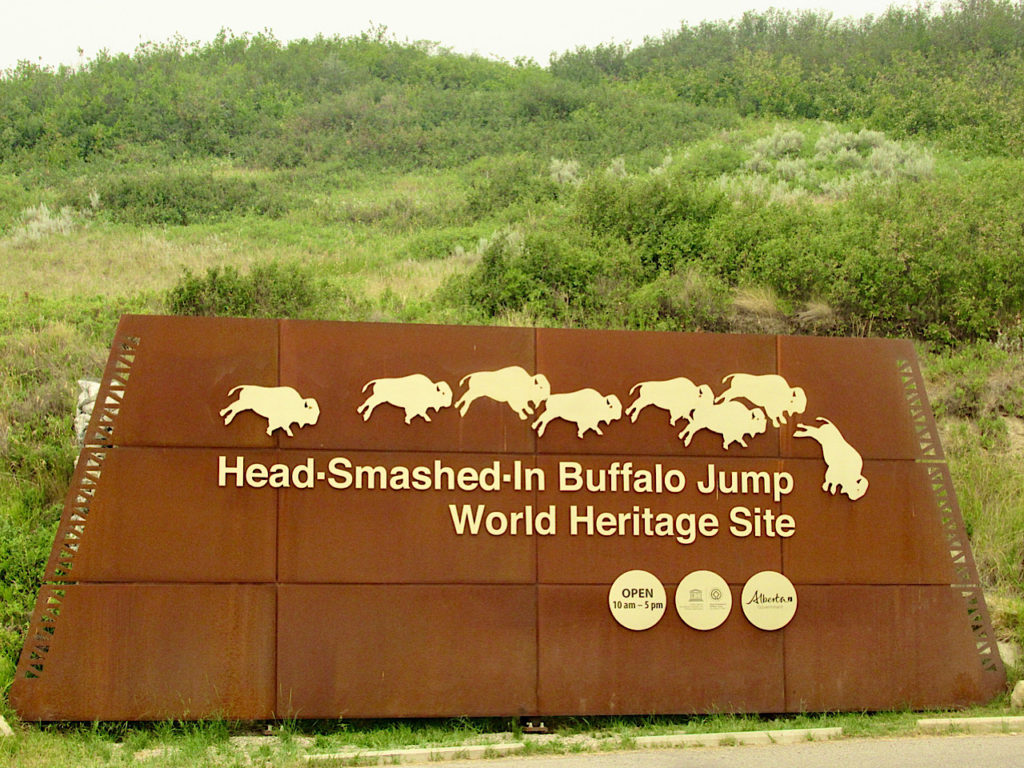
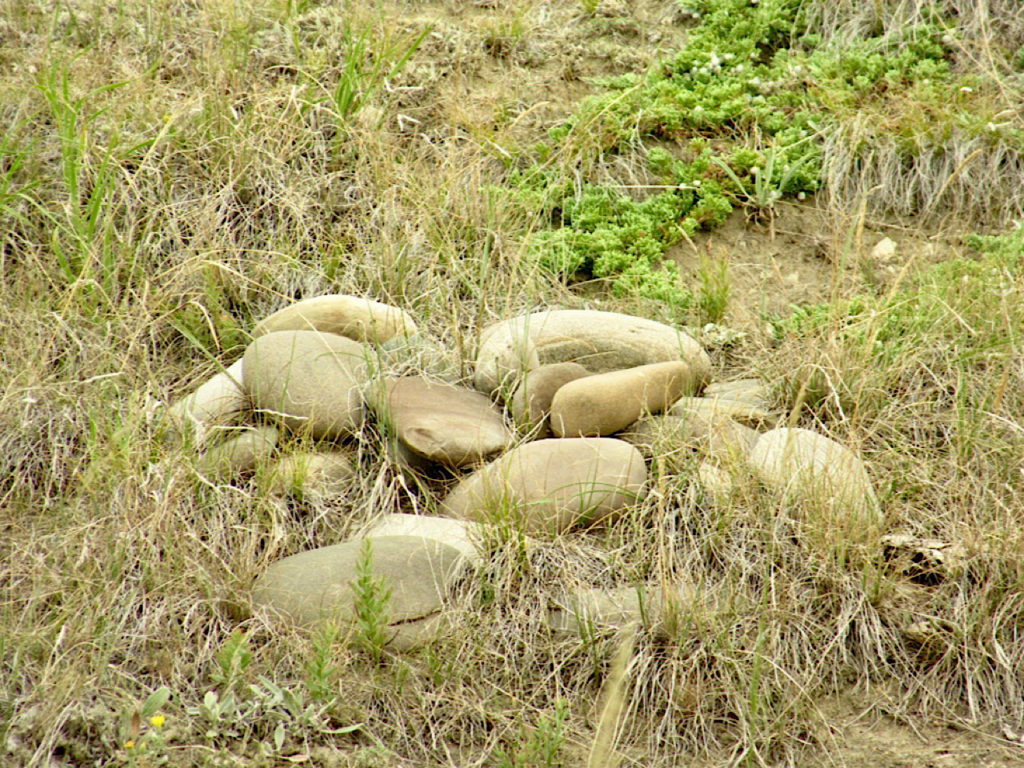

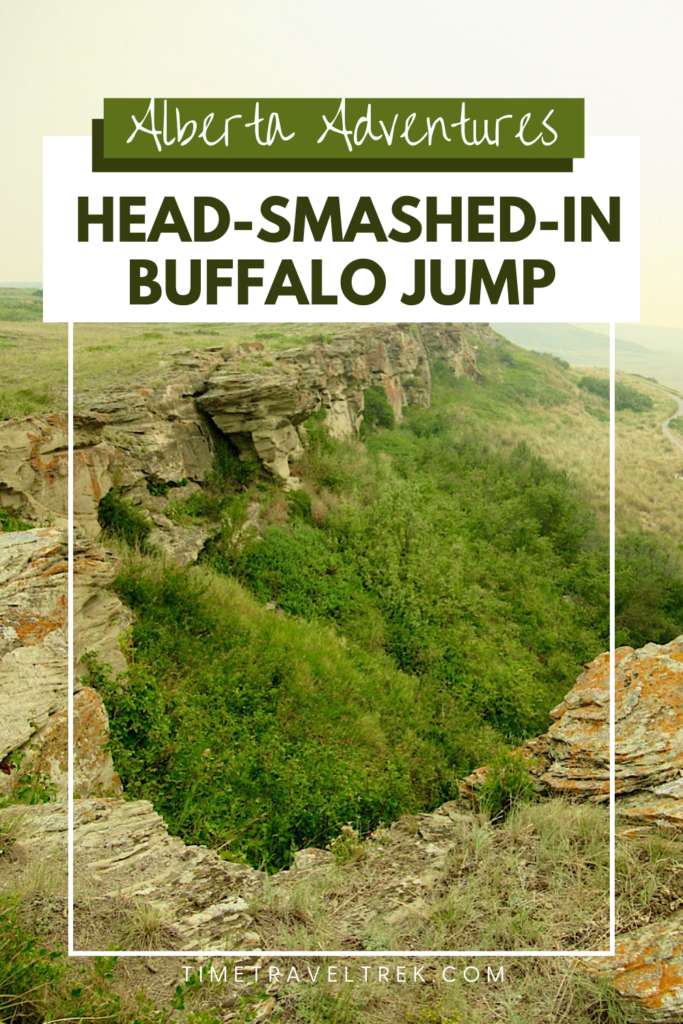
Whilst in the area, Lundbreck Falls (50km from Head Smashed In) is a great stop for a picnic and also has an excellent campsite complete with the serenade of the nearby falls to lull a person into dreamland!
Perfect tip, thanks for sharing Richard!
We ended up choosing to do 2 weeks on the South Saskatchewan in July. I had asked your opinion about that or the Red Deer. No regrets at all! What a beautiful 2 weeks we had – wildlife galore, great weather (including some intense wind storms to challenge our camp-setting skills and an outstanding electrical storm one night. 2 weeks got us from the confluence of the Olman and the Bow Rivers to Estuary, just into Saskatchewan. We had a couple of land days due to wind, and then took another day to walk / hitch into Empress which was a great experience – the friendliest of people. On more than half of our days, we saw no other humans, and had cell phone reception only as we paddled through Medicine Hat and when we walked to the top of the valley at Hwy 41 to confirm our take-out point. Fantastic experience. Would do it again in a heartbeat!
Excellent! So glad you enjoyed the South Saskatchewan; it is a beautiful paddle.
What a fascinating place!! So glad this important history is being preserved.
Agreed!
What an interesting place that I had never heard of before. Thanks for sharing this gem,
Glad you found something new in the world of travel adventure by reading this post Susan!
I am Kirby Smith with the Archaeological Society of Virginia.
How high is the cliff top from the grass or dirt below?
I was just curious.
Thank you
Hello Kirby,
The cliff face is 10 metres (~33 ft) high; how deep the bone deposits are below the grass and shrubs that now cover the jump I’m not sure. A great resource for more information is https://whc.unesco.org/en/list/158/. Cheers, M.